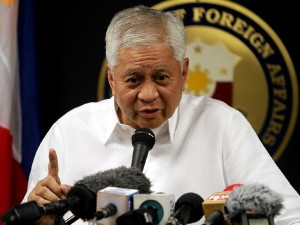US-Philippine alliance deepens amid China tensions
WASHINGTON—China’s assertive behavior is breathing life into America’s historically tumultuous relationship with the Philippines.
With Washington turning its attention more to the Asia-Pacific region, the US and the Philippines last week held the first joint meeting of their top diplomats and defense chiefs. The US increased military aid and resolved to help its ally on maritime security.
The steps came with the Philippines locked in a standoff with China over competing territorial claims in the West Philippine Sea (South China Sea) that has stoked passions on both sides. The US is walking a delicate diplomatic line. It doesn’t want the dispute to escalate, but it is showing where its strategic interests lie.
The relationship between the US and its former colony thrived during the Cold War but ebbed after nationalist political forces prompted the closure of American military bases in 1992. As the US seeks to build a stronger presence in Southeast Asia, a region it neglected during the past decade of war in Afghanistan and Iraq, the alliance is assuming growing importance.
For its part, the Philippines is looking to Washington and its allies to help equip and train the nation’s bedraggled military, to put up a show of resistance to Chinese vessels that frequently wade into waters Manila considers to lie within its exclusive economic zone.
Article continues after this advertisementErnest Bower, director of the Southeast Asia program at the Center for Strategic and International Studies, said it is very important for the US to solidify its ties with its traditional allies in the region.
Article continues after this advertisement“The relationship with the Philippines went sour when the US lost Subic Bay (naval base) and Clark (Air Base). The hangover is wearing off and interests are aligning again.”
But for both sides, managing the new chapter in their alliance is something of a balancing act and carries its own risks.
Nationalist sentiments still make an increased American military presence in the Philippines a sensitive issue, and its law forbids a foreign base on its soil. Like other Southeast Asian nations, the Philippines does not want to alienate the region’s economic powerhouse, with which it aims to have $60 billion in two-way trade by 2016.
And the US also still needs to get along with China to prevent their strategic rivalry from spiraling into confrontation.
The 60-year-old mutual defense treaty between the US and the Philippines has the potential to put Washington in hot water in standoffs like the one playing out at the Scarborough Shoal, where Philippine and Chinese vessels have been facing off since April 10. Manila appears adamant that the US would be duty-bound to come to the Philippines’ assistance should a conflict break out, but the US has hedged on the issue.
The broader trend is that for the past two years the US has declared its “national interest” in freedom of navigation and peaceful settlement of disputes in the busy West Philippine Sea (South China Sea). It has expanded its military cooperation with the Philippines into maritime security after a decade of focusing on fighting al-Qaeda-linked militants in the country’s south. And the US has increased its foreign military financing to the Philippines, which was slashed last year, to $30 million this year, double what was initially budgeted.
That, however, is little above its 2010 level, and scarcely enough to retool the decrepit Philippine fleet. To help in that effort, the US last year supplied a 45-year-old Coast Guard cutter to the Philippines, now a flag ship in its navy, which headed briefly to the Scarborough Shoal at the start of the standoff. The US plans to send a second cutter to its ally this fall and is also helping the Philippines develop its “Coast Watch” system — a network of about 20 radar stations tied to a central database in Luzon that is meant to help the island nation monitor its whole coastline.
Whether the intensified US interest will help the Philippines build the “minimum credible defense” it aspires to have is another matter. President Benigno Aquino has increased the defense budget, but it remains meager compared with most of its Southeast Asian neighbors — let alone China’s spending, which is outstripped only by America’s. The Philippines says it is looking to the US to provide more patrol boats and aircraft, and according to US officials, is also seeking help from other allies such as South Korea, Japan and Australia.
Peter Chalk, a senior political analyst with Rand Corp. think tank, said the US gifting of old hardware is a mixed blessing for the Philippines, as it is responsible for the upkeep and getting spare parts is difficult. It also risks undermining the larger goal of modernizing the Philippine military, which wants more up-to-date equipment and training — although there are doubts about the Philippines’ ability to pay for it and maintain it.
“It’s nice to get stuff you don’t pay for, but that’s not helping defense reform and modernization which the government wants,” Chalk said.
In a sign of the possible pitfalls, the 76mm main gun on the first cutter, the Gregorio del Pilar, suffered a glitch that the Philippines has to repair.
More details of the deepened US-Philippine security cooperation are likely to emerge when Aquino visits the White House this summer.
Last year, the US announced deployments of forces in northern Australia and plans to dock Navy vessels in Singapore, as it rolls out its strategic pivot toward the Asia-Pacific. There are expectations that a planned relocation of troops from Japan could involve more troop rotations through the Philippines as well.
For comprehensive coverage, in-depth analysis, visit our special page for West Philippine Sea updates. Stay informed with articles, videos, and expert opinions.
